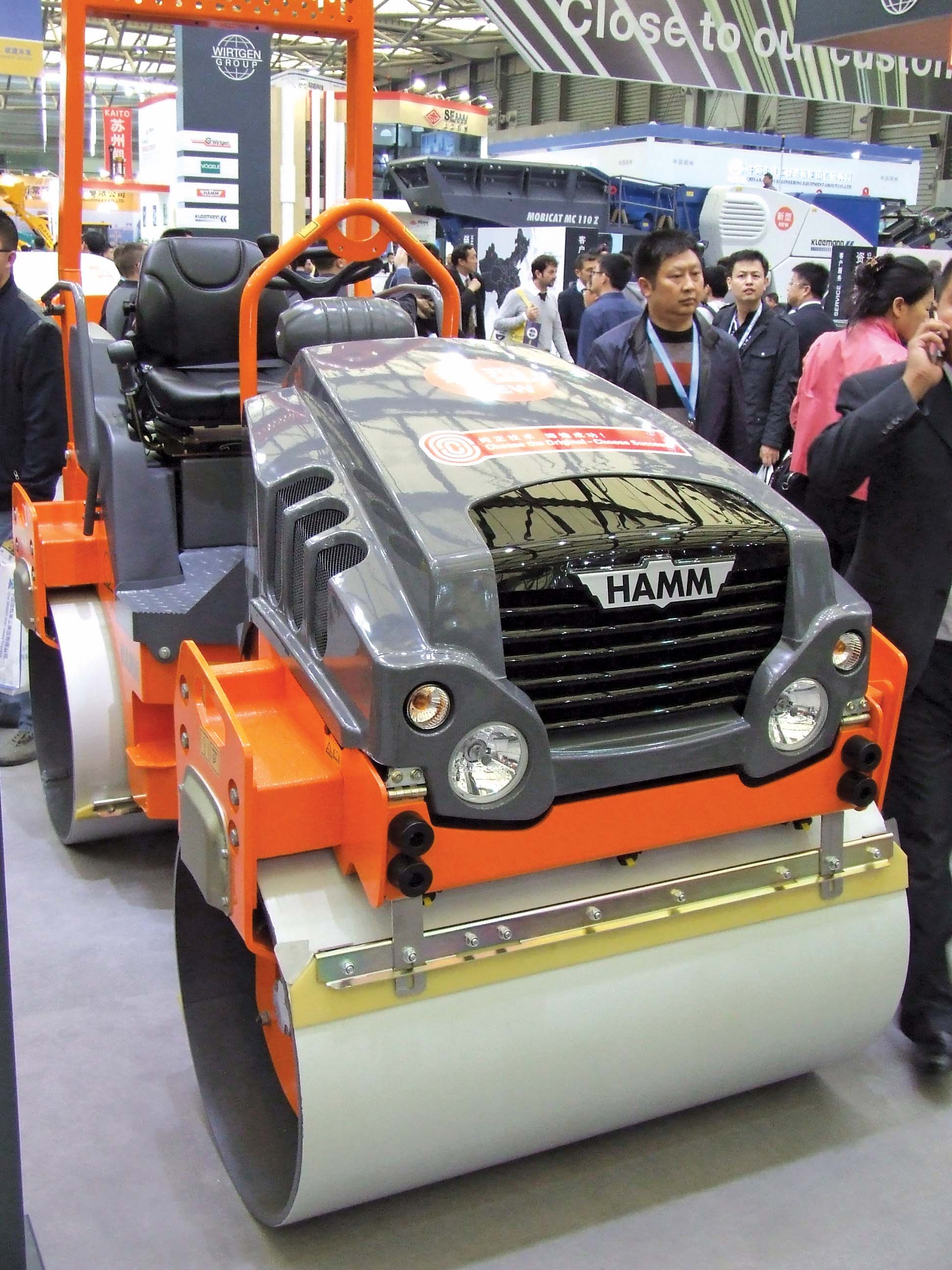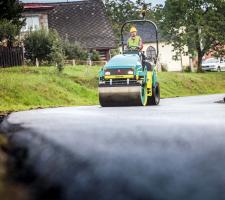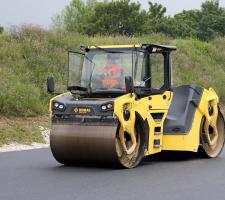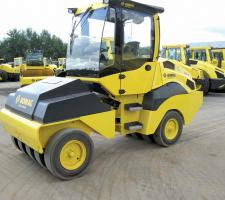
Hamm’s compact HD12VO is aimed at the Chinese market
Emissions legislation is one factor driving the introduction of new compaction machines for Europe and North America, while customers in other markets are also benefiting from new technology - Mike Woof writes
The phased introduction of new exhaust emissions requirements for construction equipment being used in Europe and North America have had a major impact on new model development. In the asphalt compactor segment, manufacturers have had to redesign machines to pack in the latest emissions control technology so as to meet the legislation.
However, while there is no need to meet these tough emissions requirements elsewhere in the world, compactor customers elsewhere have still benefited from major developments in technology. New asphalt compactors for Europe and North America are quieter and cleaner than before, as well as using less fuel and having lower running costs due to extended service intervals. And these last two features will be major advantages for construction machine customers around the globe, as many of these features are also fitted to units sold elsewhere.
6791 Ammann continues to widen its range of asphalt compactors with the addition of new models in the lightweight class for articulated tandem rollers. The range now includes 13 different models based on three basic chassis. These offer working weights from 1.4-4.6tonnes and working widths of 820-1,380mm.
These versatile units are suited to use in a wide variety of tasks in small-medium sized jobs such as urban road repairs, suiting customers from both rental and contracting segments. Power comes from Tier 3/Stage IIIA compliant7139 Yanmar diesels that offer low maintenance and fuel costs. Progressive starting and stopping is said to ensure compaction quality is optimised at the beginning or end of a pass. The ARX 36, ARX 40 and ARX 45 models are offered with dual frequency and dual amplitude selection, which broadens the range of applications. The rollers are controlled by electronic steering while the firm’s sophisticated ACEforce compaction system provides the operator with data on work being carried out, allowing continuous control of the work in hand. Ergonomic in design, the machines are said to be easier to operate, providing a good view of the drum edges.
Also new from Ammann are new variants of the ARX 90 and ARX 110 articulated tandem rollers introduced last year. The new variants include a model with a chippings spreader, one with split drums and a combi-version, featuring four rear tyres instead of a rear drum. As with the existing standard variants, the machines are available with Tier 3/Stage IIIA and Tier 4 Interim/Stage IIIB emissions compliant engines.
Atlas Copco also says that it is planning to launch new models featuring intelligent compaction technology. These will be produced at the206 Dynapac facility in Sweden and further details will be revealed shortly, as specifications were not available at the time of writing.
172 BOMAG is now introducing its 5th generation of articulated tandem rollers, the BW 191 and BW 206. These machines compete in the 12tonne and 16tonne classes and are said to be designed for use on thicker asphalt layers as well as for static compaction of open-pore asphalt. Three exciter systems are available for both models. In addition to the applications where the proven Double Vibration and Asphalt Manager features are used, the Tango Oscillation function can be used compaction in difficult areas such as on hot to cold joints, on bridges or near buildings. This last feature is controlled by a single amplitude, allowing operators to use the system more easily. The firm says that the drum will not bounce in this mode as the system works at a tangent to the surface. The feature also prevents aggregate crushing. And with the large diameter drum no bow waves are pushed ahead, even at higher working speeds.
The new tandem rollers also feature the sophisticated BOMAG Economizer system, which measures compaction and increases efficiency on site by showing progress and avoiding unnecessary passes. The machines also have large cabs with high visibility, giving the driver a clear view of the drum edge and a 360° view of the site. The engine and cab are also separated from each other and to keep maintenance simple there are no lubricating points on these rollers. All other maintenance areas are readily and quickly accessible from the ground.
Also new from BOMAG are compact rubber tyred rollers for the 4.5-11tonne market. The new BW 11 RH-5 models are articulated and feature hydrostatic drives and suit use in compacting chippings on surface dressing. The central positioning of the articulated joint is said to allow the four rear wheels to roll in the gaps between the five front wheels even when driving round bends. The result is perfect compaction and smooth and even surface quality. Also the roller excels on sites where space is limited due to its turning radius of just 2.7m. The fully hydrostatically driven BW 11 RH-5s feature three travel ranges: in first gear the drive allows maximum gradeability.
The machines have a new operator platform that benefits from single drum roller design. Meanwhile power comes from a1265 Kubota diesel that meets Tier 4 requirements while in addition to the hydrostatic braking function, these models are equipped with a dynamic service brake. Other features include ease of servicing due to maintenance-free joints.
A notable development in the compaction sector is the agreement between Hamm and1651 Wacker Neuson. Under the terms of the deal, the 228 Hamm plant in Tirschenreuth will also produce compactors that will be badged and sold under the Wacker Neuson name, initially for sale in Germany, Austria and Switzerland where the company has strong market penetration.
For Wacker Neuson the arrangement will give the firm a wider range of compactors than before, with the addition of these high quality units, which weigh from 1.8-4.5tonnes and suit sales into the rental segment. Meanwhile for Hamm, the move allows the company to capitalise on the efficiency of its Tirschenreuth plant and increase output while further reducing production costs/unit through economies of scale. The move is complimentary for both firms as Wacker Neuson’s small compaction tools do not compete with Hamm’s range of much larger machines.
Hamm’s new DV+ 70i and DV+ 90i tandem rollers are said to be highly productive machines offering good visibility and easy operation. These 7tonne and 9tonne class asphalt compactors are highly versatile and have been designed so that they can be operated in either direction. To ensure a range of options for the customer, the machines are being offered in three variants: as a double vibratory roller (VV), an oscillatory roller (VO = a vibratory and oscillatory drum) and as a combination roller (VT).
The large cab has been designed to allow the driver to see the drum edges and edge pressing device, aided by an innovative water tank configuration. The spacious cab is said to be easy to access and offers a wide range of adjustment options, while the seat in the DV+ can be rotated by 180° in either direction, allowing a driver to face in the direction of travel for all operations.
Both models are driven by the latest low emission engines, with a 75kW diesel in the DV+ 90i said to better the requirements for Tier 4 Interim/Stage IIIB legislation. Meanwhile the 56kW diesel in the DV+ 70i meets the Tier 4 Final/Stage IV requirements. Both models have diesel particulate filter (DPF) systems to remove soot particles, which also allows them to meet the tougher emissions requirements of markets such as Switzerland.
The mid-mounted engine and two-part water tank is said to optimise weight distribution, while the split drums and pivot steering allow manoeuvrability and versatility for high quality compaction even on tight corners. An automatic reverse transmission with graduated braking and acceleration helps optimise reversing, ensuring compaction is carried out without leaving bumps or hollows on the surface.
Hamm has also developed a compact asphalt compactor for the Chinese market in the shape of its 2.75tonne HD12VO. The machine is equipped with 1.2m wide drums and is powered by a diesel delivering 23kW. The compactor can generate compaction forces of 32kN and is said to be highly versatile, as it features vibration compaction on its front drum and oscillation for the rear drum.
The phased introduction of new exhaust emissions requirements for construction equipment being used in Europe and North America have had a major impact on new model development. In the asphalt compactor segment, manufacturers have had to redesign machines to pack in the latest emissions control technology so as to meet the legislation.
However, while there is no need to meet these tough emissions requirements elsewhere in the world, compactor customers elsewhere have still benefited from major developments in technology. New asphalt compactors for Europe and North America are quieter and cleaner than before, as well as using less fuel and having lower running costs due to extended service intervals. And these last two features will be major advantages for construction machine customers around the globe, as many of these features are also fitted to units sold elsewhere.
These versatile units are suited to use in a wide variety of tasks in small-medium sized jobs such as urban road repairs, suiting customers from both rental and contracting segments. Power comes from Tier 3/Stage IIIA compliant
Also new from Ammann are new variants of the ARX 90 and ARX 110 articulated tandem rollers introduced last year. The new variants include a model with a chippings spreader, one with split drums and a combi-version, featuring four rear tyres instead of a rear drum. As with the existing standard variants, the machines are available with Tier 3/Stage IIIA and Tier 4 Interim/Stage IIIB emissions compliant engines.
Atlas Copco also says that it is planning to launch new models featuring intelligent compaction technology. These will be produced at the
The new tandem rollers also feature the sophisticated BOMAG Economizer system, which measures compaction and increases efficiency on site by showing progress and avoiding unnecessary passes. The machines also have large cabs with high visibility, giving the driver a clear view of the drum edge and a 360° view of the site. The engine and cab are also separated from each other and to keep maintenance simple there are no lubricating points on these rollers. All other maintenance areas are readily and quickly accessible from the ground.
Also new from BOMAG are compact rubber tyred rollers for the 4.5-11tonne market. The new BW 11 RH-5 models are articulated and feature hydrostatic drives and suit use in compacting chippings on surface dressing. The central positioning of the articulated joint is said to allow the four rear wheels to roll in the gaps between the five front wheels even when driving round bends. The result is perfect compaction and smooth and even surface quality. Also the roller excels on sites where space is limited due to its turning radius of just 2.7m. The fully hydrostatically driven BW 11 RH-5s feature three travel ranges: in first gear the drive allows maximum gradeability.
The machines have a new operator platform that benefits from single drum roller design. Meanwhile power comes from a
A notable development in the compaction sector is the agreement between Hamm and
For Wacker Neuson the arrangement will give the firm a wider range of compactors than before, with the addition of these high quality units, which weigh from 1.8-4.5tonnes and suit sales into the rental segment. Meanwhile for Hamm, the move allows the company to capitalise on the efficiency of its Tirschenreuth plant and increase output while further reducing production costs/unit through economies of scale. The move is complimentary for both firms as Wacker Neuson’s small compaction tools do not compete with Hamm’s range of much larger machines.
Hamm’s new DV+ 70i and DV+ 90i tandem rollers are said to be highly productive machines offering good visibility and easy operation. These 7tonne and 9tonne class asphalt compactors are highly versatile and have been designed so that they can be operated in either direction. To ensure a range of options for the customer, the machines are being offered in three variants: as a double vibratory roller (VV), an oscillatory roller (VO = a vibratory and oscillatory drum) and as a combination roller (VT).
The large cab has been designed to allow the driver to see the drum edges and edge pressing device, aided by an innovative water tank configuration. The spacious cab is said to be easy to access and offers a wide range of adjustment options, while the seat in the DV+ can be rotated by 180° in either direction, allowing a driver to face in the direction of travel for all operations.
Both models are driven by the latest low emission engines, with a 75kW diesel in the DV+ 90i said to better the requirements for Tier 4 Interim/Stage IIIB legislation. Meanwhile the 56kW diesel in the DV+ 70i meets the Tier 4 Final/Stage IV requirements. Both models have diesel particulate filter (DPF) systems to remove soot particles, which also allows them to meet the tougher emissions requirements of markets such as Switzerland.
The mid-mounted engine and two-part water tank is said to optimise weight distribution, while the split drums and pivot steering allow manoeuvrability and versatility for high quality compaction even on tight corners. An automatic reverse transmission with graduated braking and acceleration helps optimise reversing, ensuring compaction is carried out without leaving bumps or hollows on the surface.
Hamm has also developed a compact asphalt compactor for the Chinese market in the shape of its 2.75tonne HD12VO. The machine is equipped with 1.2m wide drums and is powered by a diesel delivering 23kW. The compactor can generate compaction forces of 32kN and is said to be highly versatile, as it features vibration compaction on its front drum and oscillation for the rear drum.
















